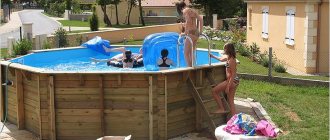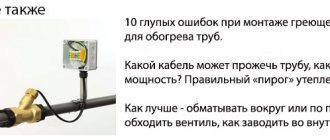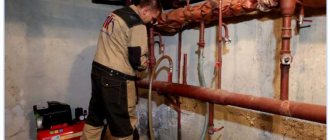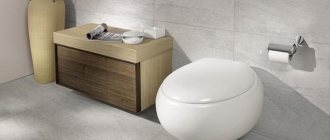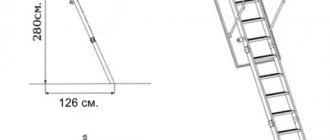Balusters are vertical supports for handrails and railings, attached to the bottom of the steps or to the side of the staircase frame. They are designed to create safe stair railings and provide the necessary rigidity for the railings attached to them. An additional, but no less important function is to decorate and create a certain style for the entire staircase structure.
Proper fastening of balusters and staircase posts ensures the safety of people when moving. The railings must be strong and stable. Therefore, the issue of choosing a technology for fastening support elements is very important when constructing stairs.
Various options for fastening balusters
The installation method is selected based on the material, shape, size and complexity of the staircase structure.
Let's look at the features of the most popular fasteners.
Dovetail cutting
A long-known method of securing balusters. Suitable for wood products only. The parts are connected using the tongue-and-groove principle without the use of self-tapping screws, a drill or a screwdriver.
On the sides of the steps there are grooves, shaped like a truncated pyramid. Holes of the same type are carefully cut from the bottom of the balusters. In this case, the compatibility of the tenon and groove must be almost perfect. The elements are connected to each other. For fastener strength, use epoxy or special wood glue.
It is important to fix the posts in a strictly vertical position until the glue hardens.
You should not take on this installation method without woodworking skills. This will be wasted time and damaged parts.
To strengthen the structure, some owners drive nails or screws into the center of the tenon, and hide the caps with overhead decorative strips.
Using bolts (capercaillie)
This makes it much easier to secure.
A long bolt with a diameter of 8 mm or more, called a capercaillie, is passed through the steps. The baluster is simply screwed onto this bolt.
The detailed installation process is as follows:
- Markings are made on the steps.
- A hole is drilled with a drill with a diameter slightly smaller than the bolt.
- The hole at the bottom needs to be made larger so that the bolt head remains hidden inside.
- This hole is drilled into the side of the baluster where the diagonals intersect.
- Now the bolt is inserted through the washer into the lower hole. A baluster is screwed onto it. When this becomes difficult to do, a ratchet (socket wrench) can be used.
- To disguise the holes, they are covered with decorative, color-matched plugs made of wood or plastic.
- When the fence begins to wobble, the plug is removed and the fasteners are tightened with a wrench. The plug is put back in place.
If the ladder is assembled from soft wood, then the hole and dimensions of the bolt should differ by at least 2–3 mm, since such a wooden ladder will become looser faster during intensive use. For hard rocks, a hole is drilled almost identical to the diameter of the bolt.
On wooden dowels
This method is appropriate when cutting or bolting balusters is structurally impossible. This is especially true when the fence will be placed on the balcony, around the stairs on the second floor or on the terrace.
The solution would be to use wooden dowels. These are small cylinder-shaped fasteners 10-16 mm high, with a diameter of 50 to 60 mm.
Fixation order:
- In a wooden base, a hole is made vertically with a drill, with a depth equal to half the height of the dowel (5-8 mm), and a slightly smaller diameter.
- A similar hole is drilled into the side of the rack.
- A little epoxy glue is poured into the hole in the floor. The dowel gets clogged. Time is given to freeze.
- After which the protruding part of the dowel is also lubricated with glue, as is the hole on the side of the stand.
- The stand is put on a dowel and positioned in a vertical position.
Craftsmen recommend buying dowels from the same type of wood as the balusters. The parts will change uniformly (swell or shrink) under the influence of external factors. The connection will be stronger.
Threaded rods
An analogue to wooden dowels are metal threaded rods. The step-by-step assembly procedure is the same as in the previous method.
Advantages over dowels are increased strength and resistance to high loads.
The connection is strengthened with glue.
Zipbolts
A reliable method of fixation, but it will be expensive.
A zipbolt is a threaded rod that has a removable gearbox at one end.
For corner joints, there is another type of zipbolt on sale - 2 studs on hinges. Used for fastening railings to the top of a balustrade.
The step-by-step fixation procedure looks like this:
- Holes are made in the balusters and steps. The length should be equal to the thread of the zipbolt without the gearbox.
- Another hole is drilled in the side of the baluster perpendicular to the first. The diameter is slightly larger so that you can insert the gear head and tighten it.
- Both holes must intersect with the longitudinal axis of the baluster.
- Now you can install the zipbolt into the rack and screw in the baluster.
- The gearbox is attached to the end hole. You will need an Allen wrench to tighten it tightly.
- The holes made are masked with beautiful plugs.
The use of zip bolts allows you to easily attach various types of balusters to the floor made of brick, concrete, and tiles. Such elements can be welded to the metal frame.
Self-tapping screws or self-tapping screws
Budget installation method. Suitable for assembling a temporary staircase, since due to such fasteners the neat appearance of the staircase is lost.
Holes for self-tapping screws are drilled in the side parts of the balusters. The holes for the heads are made wider. Screws are screwed in at an angle of 30-45 degrees.
Noticeable mounting sockets can be hidden with wood putty.
On an inclined bowstring (kousor)
Balusters can be attached to a staircase with a bowstring using any convenient method listed above.
Before fastening, the lower part of the baluster is cut down at the same angle at which the staircase goes. Then you will be able to achieve the correct vertical installation.
In the version with stringer stairs, no filing is necessary. Elements can be placed directly on the steps.
Before trimming, it is recommended to immediately determine the center of the baluster and make markings, adjust the lower part of the elements to the string, and drill to the required depth.
An alternative installation method is to use a baluster. This is an additional part, in the lower edge of which there is a groove. The groove is exactly the same shape and size as the top of the bowstring. There is the same groove in the upper part of the balusters.
The balusters will be installed on the baluster using through fasteners. Then the bowstrings are placed on top, connected with glue, and reinforced with screws or nails.
The gaps between the posts along the upper groove are hidden with a decorative strip.
As soon as one row of racks is fixed, they are clamped on both sides with slats, maintaining a vertical position.
The balusters are cut along a given line. Supports are screwed to them, and a handrail is placed on top.
The process of installing a wooden balustrade on the stairs - step by step
Now, having understood the methods of fastening balusters, we can move on to considering the stages of installation work on assembling the stair railing as a whole.
The instruction table below will present one of the options for assembling a staircase balustrade. However, it should be noted that this method is not the only one, since each master works according to his own template, developed over the years.
| Illustration | Brief description of the operation performed |
| So, after the steps of the stairs are mounted, their edge area is marked. The line for installing support posts and balusters is determined. For marking, you will need a flat metal or wooden plank with a length equal to the length of the flight of stairs, a metal ruler, a pencil and a construction square. By the way, you can use a galvanized profile, which is used for installing plasterboard structures. The profile or plank is laid along the edge of the steps, approximately at the same distance from the edge. Then, the exact distance from the edge to the plank is measured across the entire width of the step, and a line is drawn at the points found. Thus, all steps are marked. At the end of the process, all lines on the steps must coincide with the common bar. | |
| The next step is to determine the locations for fastening the support pillars, between which the balusters will be fastened. The pillars should have a cross-sectional size larger than the balusters, approximately twice as large. For example, if the balusters have a size of 50x50 mm, then the pillars should have a cross-section of at least 80x80, and preferably 100x100 mm. You can use a pin, screw or dowel to secure the support posts. If the pole is installed on a wooden surface, the length of the fastening element should be 100 mm and the diameter 8÷10 mm. In this case, these bolts with conical threads are used, like a screw. | |
| In the example shown, the upper platform on which the staircase rests is made of concrete. Therefore, calculating the action plan in advance, a so-called embed was built into the concrete at the edge of the site - this is a metal plate measuring 80×80 or 100×100 mm and a thickness of at least 4÷5 mm. On top of the plate, strictly vertically, the mentioned bolt-screw with a length of 100 mm and a diameter of 8 mm is welded. | |
| A hole corresponding to the diameter of the welded bolt is drilled in the lower end part of the support column. Then, the post is simply screwed onto a threaded pin welded to the mortgage. To ensure that the post is pressed tightly to the floor surface, the bottom of the drilled hole can be slightly widened. | |
| If the support post is installed on a plank surface, then a hole for the fastener is drilled in it, just like in the end of the post, according to pre-made markings. | |
| The post can be fixed to a horizontal surface using the same bolt. To do this, you will have to drill a through hole in the wooden surface of the stairs, and then insert the fastener from below, having first placed a wide metal washer on it. You can fix the post with a dowel, gluing it into the end of the post, and then into the hole of the step, or with a pin, screwing it first into the end of the post, and then into the step board. In a word, by any of the methods discussed above, whichever seems more convenient. | |
| Typically, the bottom support pillar in a flight of stairs is mounted on the last step and pressed against the riser of the previous step, which gives it some additional rigidity. | |
| When installing support pillars, it is necessary to ensure that they are not only perfectly vertical, but also on the same line, otherwise the staircase railings will be installed crookedly or will not be able to fit into their designated place at all. | |
| Having installed the support pillars, you can proceed to determining the mounting points for the balusters. For this procedure you will need a construction corner and a ruler. If the steps are wide enough, then it is best to attach two balusters to each of them. All elements of the balustrade must be located at the same distance from each other. Typically, when installing two balusters on each step, the distance between them is 70÷80 mm. The exact location is marked along a previously outlined general line. | |
| After the installation points for the balusters are determined, through holes are drilled through them, through which the racks will be fixed to the steps. If you choose the option of fastening using dowels or pins, then before gluing fasteners into the balusters, half of the racks will need to be shortened somewhat so that they are installed exactly under the handrail. Thus, the first baluster of the step remains at its original height, and the second, located closer to the bottom step, is shortened by approximately half the height of the step. In each specific case, the cut part will have its own size, depending on the width and height of the step. | |
| Balusters can be attached to the steps using any of the methods described above or, as in this case, using a bolt-screw screwed from below through a through hole in the step board into a hole drilled in the lower end of the baluster. A metal washer is put on the bolt, then it is inserted from the bottom of the step into the hole and screwed using a socket wrench-ratchet through the board into the hole drilled in the end of the baluster. A screw 80 mm long and 6 mm in diameter is suitable for this purpose. | |
| When all the balusters are secured to the steps, a straight guide bar is attached to them so that it passes through the upper corners of the balusters. The plank can be secured using clamps. After this, along the guide, on each of the balusters, a line for the future cut is drawn with a pencil. In addition, the vertical location of each of the racks is also marked on the guide. The balusters must be numbered so that there is no confusion during further assembly of the structure. | |
| After this, the balusters are carefully unscrewed and removed from the steps. Holes with a diameter of 5 mm are drilled in the center of their end upper part. Then, using a miter saw, cuts are made along the marked lines. The next step, according to the numbering, is to return the balusters to their original place and secure them to the guide along the pre-made marking lines. | |
| Now you can move on to working on the railings. The first thing that needs to be done is to determine the cut angle of the ends of this part, since they should be used to connect it to the support posts. For this purpose, you can use a tool such as a malka. Experienced carpenters advise simply not to change the angle set on the saw for cutting down the balusters. Before making cuts, it is necessary to accurately determine the length of the railing. To do this, they are laid on the edge of the steps, from the supporting upper to the lower pillar, and their exact length is marked with a pencil, taking into account the oblique cut. The width of the railing should be equal to the width of the support posts. | |
| After this, oblique cuts of the railing beams are made according to the markings. Next, the cut end sides must be thoroughly cleaned using sandpaper. | |
| Now on the railing beam, along its entire length, it is necessary to cut a groove, the width of which should be equal to the width of the balusters. The groove depth should be 7÷8 mm. The groove should be in the middle part of the beam, that is, it is made at a distance of 12–15 mm from the edges. To make such a groove, of course, there is no way to do without a manual or stationary milling machine. | |
| To securely fasten the railing, you will additionally need a wooden railing strip with a thickness of 8÷10 mm and a width equal to the width of the groove cut in the railing. The underrail is screwed with self-tapping screws to the upper ends of the balusters while they are fastened with a guide rail. The bar will replace the last one and fix the racks in the required position. Once it is secured, the temporary guide can be removed. | |
| Railings are laid on top of the planks and screwed to it from below using self-tapping screws. | |
| Additionally, the railings, wherever they are installed, are fixed with long self-tapping screws to the support posts. To do this, a through hole with a diameter of 5 mm is drilled from the outside of the post. First, the hole is widened so that the self-tapping screw goes deep into the wood, approximately 20 mm, passes through the post and is screwed into the end of the railing by 30–40 mm. The length of the screw is calculated depending on the size of the support post. |
Additionally, it is necessary to recall that when installing balusters in their permanent place on any fastening, it is recommended to coat their end surfaces with wood glue. It is best to do the same when installing the railing strip, as well as the railing itself. The glue, when hardened, will strengthen the structure and make it more durable.
Building a staircase with your own hands is not as easy as it might seem at first glance. To obtain a strong and reliable structure, it is first necessary to carry out accurate calculations, taking into account the lifting height, the free space that can be allocated to it, ergonomic criteria and even the height and weight of the inhabitants of the house. In these calculations, every parameter is important, from the thickness and width of the steps, to the cross-section and height of the balusters, as well as other structural details. Therefore, in order for the staircase structure to be safe and reliable in operation, it is best to entrust its calculation to specialists. And if you plan to build the staircase completely on your own, then you will need to strictly follow the drawn up drawing, observing all the dimensions indicated in it.
We mark the places for the pillars, determine the distance from the edge of the step
Before installation, it is important to correctly calculate the installation step of the balusters so that the gap between the elements is safe for movement and protects small children from falls. There is no average step rate, since each of the stairs has a different depth of steps and diameter of the racks.
Don't forget about installing vertical posts. They are placed at the beginning and end of a flight of stairs. When the span length exceeds 1.5 m, it would be correct to strengthen the structure with additional pillars.
If the step issue is resolved, then you can start marking. Marks are placed on the string and treads. All axes of the racks must run along the same line parallel to the axis of the staircase itself.
The option of applying only the first and last point of the tread will help speed up the marking process and its accuracy. Next, a flat wooden strip with a metal corner is applied, and the remaining marks are quickly drawn in line.
An important point: in order to secure the balusters and railings on the stairs, where the steps hang on the sides, you need to step back at least 2–5 cm from the side edge of the step.
To obtain the exact distance, the size of the support or baluster is divided by two, and the minimum permissible distance from the edge is added (2–5 cm depending on the design).
On the sides of the supports and balusters, draw diagonals from opposite corners. At their intersection there will be an axial center. If the elements have a circular cross-section, then two diametrical lines are drawn. Along the top of the treads, along the already drawn line, mark fixation points with the same step. These points are aligned with the axes. The straight line of the balustrade is ready.
The order of assembling the railings
In order for the installation of railings on the stairs to take place without surprises, you need to clearly understand the whole process.
- The two outermost pillars are fastened - at the top and bottom of the span. They are placed so that there is the same distance from the edge of the pillar to the edge of the step (usually 3-6 cm). If the staircase is made on a stringer, they are placed by aligning the edges, or making sure that there is the same distance on both sides.
- A rope is stretched between two mounted poles. Self-tapping screws are screwed into their center, twine is pulled, along which it will be necessary to set the centers of the installed balusters and pillars, it will be possible to check the height, etc. Instead of a rope, you can install a guide if you are sure that it is level and does not sag anywhere.
The procedure for assembling stair railings consists of several sequential steps - Balusters are attached and pillars are placed according to the existing markings. Their position is strictly vertical and so that the top is level with the thread/guide.
- When installing each element, its position is verified: The pillars/balusters must stand strictly vertically, without the slightest deviation. It is necessary to check in two planes.
- They should be in line with those already installed, not “walking” to the right or left.
The process is then repeated for the second span. The last thing to complete the installation of the railings is the union of the support posts at the turning point. The specific method depends on the type and material of the handrail, but you need to manage to make this section a transition from one span to another, while being comfortable and not seeming alien.
Do-it-yourself fastening of balusters to stairs made of different materials
Stairs made of wood and metal are considered the most practical and are installed more often, so we will analyze the installation of balusters for them.
Wooden
Natural wood looks very impressive, and when decorated with carved details it gives the room majesty.
Wooden elements must be fastened carefully. Raw materials can shrink or swell under the influence of moisture. Over time, the fasteners become loose and the structure begins to lose strength.
To install balusters to a wooden staircase, you should choose methods that require tightening the connections (zip bolts) during operation. It will be reliable to use threaded rods.
Wooden dowels with glue are often used on stairs that are not subject to loads (decorative fencing on the porch, veranda).
Metal
There are metal balusters:
- iron;
- steel (nickel-plated, chrome-plated);
- made of stainless steel;
- forged.
For fastening to a wooden staircase, special plates with holes for self-tapping screws are welded at the top and bottom of the pillars. To attach to a concrete surface you will need dowels and expansion anchors.
To install forged balusters, it is important to carefully hide the place of fixation, otherwise the look will be ruined. To do this, take screws decorated to match the style of the staircase.
You can use hinges to fasten poles. There are decorative types on sale that fit perfectly into the overall appearance of the structure.
It is convenient to use thrust bearings for mounting metal balusters. They are screwed to the steps or ends of the stairs. Balusters and pillars are attached to these fixed thrust bearings. You just need to choose the right size for the bearings.
Detailed installation instructions look like this:
- We carry out the markup as described in the section above.
- We select balusters. We distribute them among each other at the same distance.
- We set the heel pads according to the marks. They are fixed with 3-4 self-tapping screws (in wooden stairs, laminate floors, WPC), dowels (for concrete, brick steps).
- We screw the balusters or pillars into the bearings. We set it vertically.
- We weld on four sides. This reduces the risk of loosening and deformation of the structure.
- We install handrails.
An alternative to a welded connection is the use of clamping screws. But experts note that the screws quickly unscrew and often have to be tightened, therefore, if the thickness of the metal elements is 1 mm or more, welding will be more reliable.
Variety of balusters based on material of manufacture
If earlier such architectural elements were made of stone, wood or clay, and later they began to be made of concrete, gypsum and metal, today polymers (most often polyurethane) have been added to these materials. And in order to understand how the racks differ from each other, and which of them can be used on a wooden staircase, it is necessary to consider them in more detail.
Plaster and concrete balusters
Balusters made of concrete and gypsum can be combined into one group, since they are made using the same technology. These types of figured posts are a classic option; today they are mainly used for various areas of the exterior design of a building - this can be the fencing of balconies, terraces, stairs, as well as the eaves lines of flat roofs.
Gypsum or concrete balusters can be made individually, or even sectionally at once
The framework for balusters made of concrete or gypsum is a reinforcement cage. It is placed in a special mold, into which the solution is then poured. After removing the finished products from the molds, they are sent, if necessary, to the grinding process.
Molds for casting balusters - piece or block
When completed, the “classic” baluster takes the shape of an elongated flowerpot, intercepted in a narrow place by a ring. The creation of this most common form of staircase post is attributed to the famous Italian scientist, artist and architect Michelangelo.
If cast balusters are intended for use outdoors, they are impregnated with special compounds and, if necessary, painted.
Prices for balusters
baluster
Previously, similar elements of balustrades and stair railings were manufactured as separate products, from which the overall composition was built. Nowadays, quite often sections are poured out entirely, and the entire fencing structure is assembled from them. Moreover, the sections can be straight, curved at different angles or semicircular, depending on the shape of the staircase or balcony landing that they should enclose. In order for the sections to be precisely adjusted to the area intended for them, they are most often made to order, with the necessary measurements taken.
The disadvantage of these designs is their fairly high price, as well as a very considerable mass of products. Therefore, both single balusters of gypsum or concrete, and sections of them are almost never used to enclose wooden stairs.
Methods for installing balusters to the floor
Depending on the floor material, the fastening parts and installation sequence differ.
Wooden
Floor installation of racks is carried out for the lower and upper parts of the stairs.
There are two ways to fix it:
- Holes are drilled in the floor. Metal studs are installed, on which there is a metric thread on one side and a conical thread on the other, like on screws. A baluster is screwed onto them.
- The pin is screwed into the support and then inserted into the hole on the floor.
It is not recommended to assemble balusters using self-tapping screws. Practice has shown that this is an unreliable method, although it is cheap.
Concrete
If the house has a concrete floor, what are used for installation:
- Expansion anchors with reverse tapered thread. Sold specifically for monolithic concrete surfaces. A hole is made in the floor with a diameter the same as the diameter of the anchor. The pin is screwed in. The support is screwed onto a pin protruding from the floor. To increase the reliability of the fastener, it is better to lubricate the stud with glue.
- Embedded elements. A hole with a depth of 8 cm is made in the concrete. Embedded metal elements are placed in it. They should have a tapered or metric thread at the top. The hole is filled with cement mortar. Work may be continued only after it has completely hardened. A baluster is screwed onto the protruding piece of the mortgage.
The first method is cheaper and will be completed faster.
Why is it important to carefully select and attach balusters?
Beautiful balusters are not only an opportunity to give the staircase a finished look and make it unique. They will help make it a full-fledged element of the interior. But, despite this aesthetic aspect, balusters, first of all, must be strong, reliable and well secured. Otherwise, there is a risk of injury to those walking on the stairs.
Glass balusters
Important! Balusters made of glass, even of the highest quality, usually perform a decorative function - you should not rely on their reliability, therefore it is not recommended to install them in a house whose residents lead an active life.
Balusters must have a reliable base in order to be well secured. It is also recommended to install them so that the child’s head cannot pass between them. You can experiment with other aspects of their installation and appearance as you wish. But you should not order them in the form of some unreliable or extravagant elements - in case of drastic changes in the interior, the balusters will also have to be changed, and if they are thin, then there is a risk that in the event of a strong impact when a person falls on them, they simply will not withstand and they will break.
Rules for installing balusters
The nuances of installing railings on balusters
To connect elements the following are used:
- self-tapping screws;
- dowels;
- lubrication with glue;
- flat wooden strip.
It is important to correctly determine the length of the screws so that after installation the tip is not visible from the outside of the railing. It is better to take finishing ones with a small cap.
Fastening using a rail is similar in principle to using a baluster to install racks on a bowstring.
The use of a handrail will simplify the fastening of the railings. It looks like a board. Supports are mounted right through to it from above. The top handrail is covered with a railing. They can be either the same or different in thickness and width.
Builders often use a hidden method of installing railings on studs and dowels. The order is as follows:
- In the middle of the balusters we place dowels and metal pins (optional).
- We set up the supports, keeping them vertical, and fix them.
- We put railings on top. It's better to do this together. One holds the handrail, the other taps it with a hammer.
- We lay the block over the support. We hit it with a hammer. A mark is formed at the bottom of the handrail. We make a hole.
- We put these marks on each of the balusters. We make holes.
- We check the evenness and correctness of the docking.
- We remove the handrails. We apply glue to them.
- We put it back. Tap gently on top with a hammer.
- The railings are ready.
For temporary stairs, balusters are mounted to the handrail with nails or self-tapping screws (optional) at an angle. For stability, two fasteners are made on each side of the support.
Video description
The method of attaching balusters to dowels is shown in the video:
If supporting pillars of large cross-section are attached using this method, then instead of one central dowel, it is recommended to use 4, evenly distributing them along the plane of the end. Or install it on a long, large-diameter stud.
- Tongue and groove fastening.
This method of securing balusters can be used when the edge of the step protrudes slightly beyond the stringer and has a slight overhang. To do this, a trapezoid-shaped tenon is cut out at the bottom of the baluster, and a counter groove of a similar configuration is made at the end of the step. All planes of the groove and tenon are well lubricated with glue and connected, fixing the structure until the glue dries completely in a vertical position.
This joinery joint is called a “dovetail” Source airmatic.ru
End (side) fastening
This is how the installation of balusters of glass, wooden, and metal stairs is carried out. In this case, the gaps are filled with various materials, that is, the sidewall is made closed.
For fixing metal and glass, a special clamp is purchased, which is attached to the wall. It has a groove, a post fastening system. Made of wood - mounted through threaded rods, zip bolts, dowels. Hats are hidden under decorative plugs. There are two clamps per support. They are attached at a distance of 5-10 cm from each other.
The number of racks is determined by the bearing capacity of the base. For a floor made of wooden flooring, the step between the posts is from 50 to 80 cm; for concrete floors, a larger step is taken. It is better to apply glue to the side of the racks. This will make the structure stronger.
You can install balusters on your own if you take a responsible approach to marking and selecting parts for fasteners. When choosing a material, evaluate both decorativeness and practicality, and duration of use.
Installation of fences and balusters
A proper staircase always consists of several elements, some of which are needed in large quantities - their number often depends on the length of the flight of stairs. The main details of this design are as follows:
- railings or handrails to hold on to while climbing;
- steps , along which, in fact, a person rises to the floor above;
- balusters , which are special columns that support the railing and create a kind of fencing on the stairs;
- there may also be support pillars on which the entire structure rests.
Basic elements of assembled wooden stairs
Balusters, as mentioned above, are columns that are installed on the steps under the railing. They act as supports for the railings themselves, and also act as fences. Any staircase that has 5 or more steps should have them.
On a note! These supports also have an aesthetic role - with their help, a staircase can be turned into a real work of art. After all, balusters can have very different configurations and look quite beautiful.
Each rack has a support, a central part and a base. The center is usually made in a beautiful form to give the structure an interesting look and make the staircase part of the interior. And the support and base-end are needed in order to be able to attach the post to the floor and handrail.
Artistic and decorative handmade wooden balusters
What types of balusters are there?
These elements can be made from almost anything. They are usually made of wood, glass, concrete, stone or metal alloys. For the manufacture of wood products, species such as birch, pine, beech, and oak are used. Metal elements can be made of bronze, steel, and various alloys.
Contrary to popular belief that wrought-iron staircases fit harmoniously only into classical interiors, as well as interiors in the Gothic and Baroque styles, they will be a beneficial addition to other stylistic solutions
Conventionally, all balusters made of wood can be divided into 3 groups.
Table. Types of wooden balusters.
| Group | a brief description of |
| Chiseled | They are made using lathes and are usually shaped like rotating bodies. |
| carved | Can be made manually or using a programmable multi-axis machine. |
| Milled | Such elements are decorated with a mass of carved elements and have screw, longitudinal, and oblique cuts. |
Installation of concrete balusters
But concrete balusters usually have the shape of flowerpots or resemble small columns in appearance. In general, these elements from any material can be flat, point (round) or sculptural.
Ordinary and supporting balusters for wooden stairs
On a note! The distance between adjacent balusters should not exceed 15 cm, and the height between steps and railings (that is, the height of these elements) cannot be lower than 90 cm.
How these elements of the staircase structure will be attached will directly depend on the material from which they are made. But no matter how beautiful the balusters are, the most important thing is that they are securely fastened to the base of the floor, steps and railings.
Prices for balusters for stairs
balusters for stairs
Video description
The zipbolt installation process is shown in detail and easily in the video:
Installation of wooden balusters on a string
Attaching balusters to the string of a wooden staircase is carried out using all the methods described above, but with the difference that their lower part must be cut at an angle in order to achieve a vertical position.
If you choose an installation method that involves drilling holes in the end of the support, then first find the central point, drill a hole, and only after that make an oblique cut for installation on the bowstring. Otherwise, it will be much more difficult to find the center and make a strictly vertical hole.
When connecting into a dovetail, a counter groove is made in the bowstring, and after the final assembly of the structure, it is covered with a decorative overlay.
Mounting on a bowstring allows you to use another method of fastening - using a baluster. This is the name given to the overhead strip, to which all the balusters are first attached with bolts, screws or dowels, and then the assembled structure is installed on a string and fixed with glue, nails, and screws.
Balusters are also used to construct a balustrade around a staircase opening Source stroy-birzha.ru
Finally, when attaching balusters with self-tapping screws or nails to a string, it is easy to hide the heads of the hardware by attaching short strips between adjacent supports on the string, the thickness of which will allow you to cover the entry points of the hardware.
Installation of balusters on a solid base
A staircase with balusters can have concrete steps or tiled steps. To install a fence on them, it is advisable to take care of embedded bolts or studs in advance, since fastening to dowels or self-tapping screws is impossible in this case.
Embeds for the balusters of a concrete staircase are installed at the stage of pouring the solution into the formwork Source staircase-on-metal.rf
General characteristics of stair railing posts
Layout of the staircase.
The distance between staircase railing posts in residential apartment buildings and common areas is in most cases determined by SNiP, which is based on GOST 25772-83 of the USSR 30 years ago. According to this document, the distance between racks on flights of stairs, landings, balconies and roofs can be:
Maximum deviations of dimensions of 300 mm and less are 1 mm. This does not apply to fencing steel platforms and stairs. On the balconies of modern high-rise buildings, fencing of this type is now practically not used.
Ladder size diagram.
When independently building country houses and country houses, the issue of installing flights of stairs, large and not very large, is always relevant. Particular attention is paid to the appearance of the stairs installed between floors indoors. With all the variety of staircase structures, the railings installed on them are most often decorated with balusters.
Video description
Another way to install balusters on concrete steps is shown in the video:
Fastening metal balusters
In the case of tubular metal fencing for stairs made of stainless or chrome-plated steel, its fastening is carried out using special clamps. These can be thrust flanges, which are used to fasten balusters to the floor or steps, or holders that are installed on the side of the stairs. Both are available in different shapes and sizes; they just need to be matched to existing poles and racks.
When installed on steps, the clamps are screwed to them with self-tapping screws or secured with dowels or anchors, depending on the base material. And the racks in them are clamped with screws or welded. After installation is complete, a decorative cover is placed on the fastener to hide hardware or welds.
For the assembly of metal fences, they also produce other fastening and connecting fittings Source profmetspb.ru
To install forged balusters from a steel bar, another method is used: a threaded rod is welded to their lower part. It is fixed with a nut and washer on the lower plane of the step. If there is no access to the “underside” of the stairs, then drill a hole in the step and glue a nut into it.
Installation of balusters: how to choose the optimal distance
First, let's remember what balusters are. These are vertical posts that are used in the construction of staircases, balcony railings, balustrades or gazebos.
The distance between racks on flights of stairs, landings, balconies and roofs can be: 1 - no more than 150 mm, 2 - no more than 300 mm, 3 - no more than 100 mm for preschool institutions.
The main purpose of balusters is to give the entire structure greater rigidity and ensure safe movement along the stairs or balcony. In addition, such racks usually serve as decorative elements that complement the overall style of the interior of a room or building.
Therefore, choosing the optimal distance between balusters means giving the structure an aesthetic and attractive appearance.





